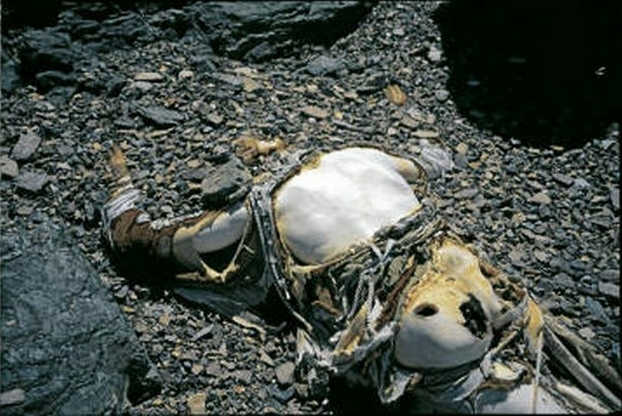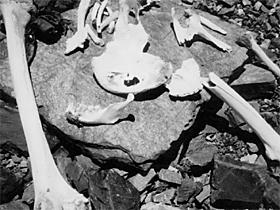Mount Everest
A monument to greed, or perhaps a tomb, or, even further back, a holy mountain, desecrated again and again until all meaning was lost.
Explanation
Mount Everest is a mountain on the border of Nepal and Tibet. It is, with snow, 8,848.86 meters tall, or approximately 29,031 feet, making it the highest peak in the world. As of November 2022, 310 known people have died there, although it's probably more because the mountain still existed before it was 'discovered' in 1852. in Nepal, it is called Sagarmāthā, meaning 'the head in the great blue sky'. in Tibetan, it's called Qomolangma, or 'holy mother'. The name 'Mount Everest' comes from sir George Everest, a former Surveyor General of India (Basically, the guy in charge of mapping the country and surveying the land. This position still exists to this day). This man himself didn't think this was a good idea, as he believed that the local people would not be able to pronounce it. In the end, he never even saw the mountain that was named after him.
Regardless, whatever you may call it the mountain still exists. Due to its height people have been climbing the mountain since way back in 1922. Reaching the peak of the mountain is the 'ultimate challenge' for a lot of people. It is incredibly dangerous, and near the top of the mountain the wind can blow at 320 KM/H. Many people tried to get to the top, but the first recorded people to make it (and survive) were Sir Edmund Percival Hillary and the sherpa (ethnic population of Tibet, known most famously for frequently working as guides for those climbing mountains) Tenzing Norgay in 1953. Before this, the person most likely to have made it to the top was George Mallory, who died near the top of the mountain. Nobody knows if he made it to the top or not so Hillary is seen as the first person to 'officially' make it. Nowadays, technology has improved so much (think oxygen, GPS, etc) that every year more than five hundred people make it to the top.
If you're lost, just follow the trail of corpses!
George Mallory died in 1924. He'd been on Everest before, in 1922, as part of an official British expedition. However, this expedition ended in death-- an avalanche killed seven members of the expedition. Mallory did not see this as an omen of death, however, and returned to Everest two years later. They attempted to climb thrice-- with the third time consisting of Mallory and a man named Andrew Irvine. They put down their camp near the summit, and the last person to see them alive was Noel Odell, who watched them disappear into the clouds and towards the summit. Back at the camp (camp VI, to be exact) Noel found the tents belonging to the pair but without any note of when they'd started towards the top of the mountain or when they'd come back. After four days of waiting without seeing either of them, Odell tried once to follow their route to find them, but it was no use, and he sent out the sign that meant there had been a death on the mountain.
George Mallory's body wasn't found until the year 1999. Irvine's body was never found.



Maurice Wilson was an absolute madlad who, after having read the story of Mallory and Irvine, thought 'hey, I could do that!' and attempted to reach the top of Mount Everest even though everyone in his life told him not to. After returning from fighting in World War 1, he had trouble readjusting to civilian life after he'd been injured in battle. He got into mysticism, saying that a mysterious man taught him to cleanse himself by fasting and meditating for one hundred days straight, although some people believe this man never existed. Regardless, this newfound mysticism led Maurice to believe that climbing Everest was his cosmic duty. He set about getting his pilot's license (he was a terrible student, and took ages getting his permit. His instructor thought he would never fly to India and survive), bought a small plane (Named the 'Ever Wrest'. Ha ha.) and left for Everest without any specialized equipment because he believed that just by looking at the mountain he knew exactly what he needed.
He did make it to the mountain eventually, where he climbed on his own and kept a diary, the biggest source of information on how his trip went. Apparently he twisted his ankle, his wounds from the war hurt him badly while climbing, and the weather had a bad effect on him. He gradually got sicker and sicker, and eventually he didn't even get out of bed anymore, all while still in one of the base camps on the mountain. His last diary entry read, 'Off again, gorgeous day.' His body wasn't found until a year later, which is when they found his diary and buried his body in a crevasse. It's unknown if the bodies below are his-- I doubt it, honestly, but these were both labeled as Maurice Wilson by two separate websites so I thought I'd include them regardless.


Hannelore Schmatz was the fourth woman to ever get to the top of Mount Everest. Most famously, however, she was the first ever woman to die on Mount Everest. (not the best achievement to get, but, as my friend pointed out, it would be worse if your biggest achievement in life was to be the third woman to die on Everest.) She was a German woman who climbed the mountain with her husband, Gerhard. Hannelore died along with an American who was on her expedition, Ray Genet, but his body was lost. Hannelore's was lost too, but more recently, allowing for a picture to be taken. Her corpse was described to look lifelike, like she was only briefly resting. As she died, she told a sherpa she needed water. After her death, the sherpa remained with her, which caused most of his fingers and toes to freeze off. While her body was still there, Arne Næss Jr. described her with hair "waving in each gust of wind. [...] She summited, but died descending. Yet it feels as if she follows me with her eyes as I pass by. Her presence reminds me that we are here on the conditions of the mountain."

Joe Tasker and Peter Boardman were a duo of climbers who died on the mountain in 1982. The pair had climbed many times before, together as well as separately, and had also tried Everest a few times before, though it kept not working out. Boardman's body was found in a sitting position at the 'three pinnacles', a formation of especially steep rocks at around 7800 to 8200 meters up the mountain. This was, as far as I can find, the first recorded attempt at this way up the mountain. People generally avoid it due to it being, well, avoidable, and quite a lot more dangerous than the regular route. Tasker's body was never found, but it's assumed he died somewhere nearby and he, or his body, fell off the mountain. The image below is not of either of them, but it does show others traversing the Pinnacles, just to give an insight into how treacherous the path is. The two had reasons enough to believe they could make it-- they were both experienced mountaineers. But Everest isn't kind, even to those who are well-prepared. In the same year, down to the same season, another climber died, the American woman Marty Hoey, who would have, had she not plummeted 8000 meters to her death due to an unsecured climbing harness, been the first American woman to make it to the top of Mount Everest. One of the men she was with, Whittaker, said that it was a beautiful death, because she "Fell into the prettiest place that ever was." after her death, the others in her group did not make it to the top, though they felt that they would have if she'd been there. She was the only American to die on Everest that year.

Karl Gordon Henize was a NASA astronaut who spent seven days in literal space, only to go on and die on Mount Everest at a later date. In his lifetime, he discovered more than 2000 stars. He climbed Everest both because he enjoyed climbing mountains, but most importantly because he wanted to test the TEPC (Tissue Equivalent Proportional Counter) at several altitudes. He died on Everest due to high altitude pulmonary edema, which means that liquid enters the lungs in otherwise healthy people because they're used to a much lower altitude and their body can't handle it. A milder form of this is 'altitude sickness' which, while making people ill and nauseous, usually isn't fatal. You can also get this in reverse, when you're used to a high altitude and enter a low one.
Natural Mummification
Natural Mummification happens when a body is preserved due to natural conditions, like extreme heat or cold, or because of certain chemicals found in the ground where someone is buried, causing them to be preserved. Mummies created in this manner are also called 'Spontaneous Mummies'. This group includes Bog Bodies (another interest of mine), bodies found in desert caves (preserved due to an extremely dry, hot environment), bodies encased in ice, et cetera. Many bodies that are found on Everest (especially higher up the mountain) are preserved remarkably well despite being decades old. This is, as you can guess, also because of the cold. There are quotes mentioning lifelike bodies with eyes following (living) climbers around. Because the bodies are so well-preserved, many were (and are) used as markers so people know if they're on track on their way up. Though, in more recent years people have started trying harder to remove bodies from the mountain, to 'preserve their dignity' or 'give them the respect they deserve'. Bodies such as 'Green Boots' (widely believed to be Tsewang Paljor) were used as landmarks for years, though in 2014 his body was moved to a less obvious location by a Chinese expedition. Francys Arsentiev, known as 'Sleeping Beauty', was also moved in 2007. At such heights, it's near impossible to retrieve the bodies, so instead of bringing them back and returning them to their families, they're hidden behind outcroppings of rocks, for example. It's debatable whether this actually helps anyone or if people are desecrating corpses so they can make themselves feel like a good person.
Conclusion
Don't climb Mount Everest. Obviously. Worst case scenario is dying in like, a thousand separate horrible ways. Slowly freezing to death, blackened fingers slogging off as you walk. Falling kilometers down a hill and being impaled on a sharp rock. Best case scenario, you get on top of a mountain, littered with trash. Might as well just go to any large city. Maybe I just don't get it, I can accept that opinions differ. But unless you're a very good mountaineer (and even then!) I would encourage you to climb some other, less deadly hill.
